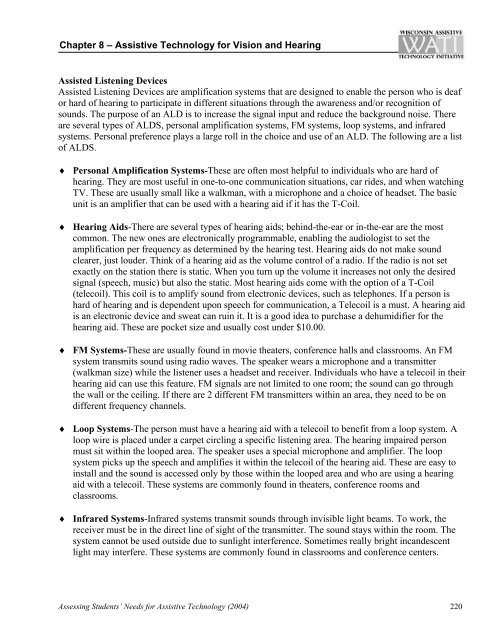Assessing Student's Needs for Assistive Technology (ASNAT)
Assessing Student's Needs for Assistive Technology (ASNAT)
Assessing Student's Needs for Assistive Technology (ASNAT)
You also want an ePaper? Increase the reach of your titles
YUMPU automatically turns print PDFs into web optimized ePapers that Google loves.
Chapter 8 – <strong>Assistive</strong> <strong>Technology</strong> <strong>for</strong> Vision and Hearing<br />
Assisted Listening Devices<br />
Assisted Listening Devices are amplification systems that are designed to enable the person who is deaf<br />
or hard of hearing to participate in different situations through the awareness and/or recognition of<br />
sounds. The purpose of an ALD is to increase the signal input and reduce the background noise. There<br />
are several types of ALDS, personal amplification systems, FM systems, loop systems, and infrared<br />
systems. Personal preference plays a large roll in the choice and use of an ALD. The following are a list<br />
of ALDS.<br />
♦ Personal Amplification Systems-These are often most helpful to individuals who are hard of<br />
hearing. They are most useful in one-to-one communication situations, car rides, and when watching<br />
TV. These are usually small like a walkman, with a microphone and a choice of headset. The basic<br />
unit is an amplifier that can be used with a hearing aid if it has the T-Coil.<br />
♦ Hearing Aids-There are several types of hearing aids; behind-the-ear or in-the-ear are the most<br />
common. The new ones are electronically programmable, enabling the audiologist to set the<br />
amplification per frequency as determined by the hearing test. Hearing aids do not make sound<br />
clearer, just louder. Think of a hearing aid as the volume control of a radio. If the radio is not set<br />
exactly on the station there is static. When you turn up the volume it increases not only the desired<br />
signal (speech, music) but also the static. Most hearing aids come with the option of a T-Coil<br />
(telecoil). This coil is to amplify sound from electronic devices, such as telephones. If a person is<br />
hard of hearing and is dependent upon speech <strong>for</strong> communication, a Telecoil is a must. A hearing aid<br />
is an electronic device and sweat can ruin it. It is a good idea to purchase a dehumidifier <strong>for</strong> the<br />
hearing aid. These are pocket size and usually cost under $10.00.<br />
♦ FM Systems-These are usually found in movie theaters, conference halls and classrooms. An FM<br />
system transmits sound using radio waves. The speaker wears a microphone and a transmitter<br />
(walkman size) while the listener uses a headset and receiver. Individuals who have a telecoil in their<br />
hearing aid can use this feature. FM signals are not limited to one room; the sound can go through<br />
the wall or the ceiling. If there are 2 different FM transmitters within an area, they need to be on<br />
different frequency channels.<br />
♦ Loop Systems-The person must have a hearing aid with a telecoil to benefit from a loop system. A<br />
loop wire is placed under a carpet circling a specific listening area. The hearing impaired person<br />
must sit within the looped area. The speaker uses a special microphone and amplifier. The loop<br />
system picks up the speech and amplifies it within the telecoil of the hearing aid. These are easy to<br />
install and the sound is accessed only by those within the looped area and who are using a hearing<br />
aid with a telecoil. These systems are commonly found in theaters, conference rooms and<br />
classrooms.<br />
♦ Infrared Systems-Infrared systems transmit sounds through invisible light beams. To work, the<br />
receiver must be in the direct line of sight of the transmitter. The sound stays within the room. The<br />
system cannot be used outside due to sunlight interference. Sometimes really bright incandescent<br />
light may interfere. These systems are commonly found in classrooms and conference centers.<br />
<strong>Assessing</strong> Students’ <strong>Needs</strong> <strong>for</strong> <strong>Assistive</strong> <strong>Technology</strong> (2004) 220











